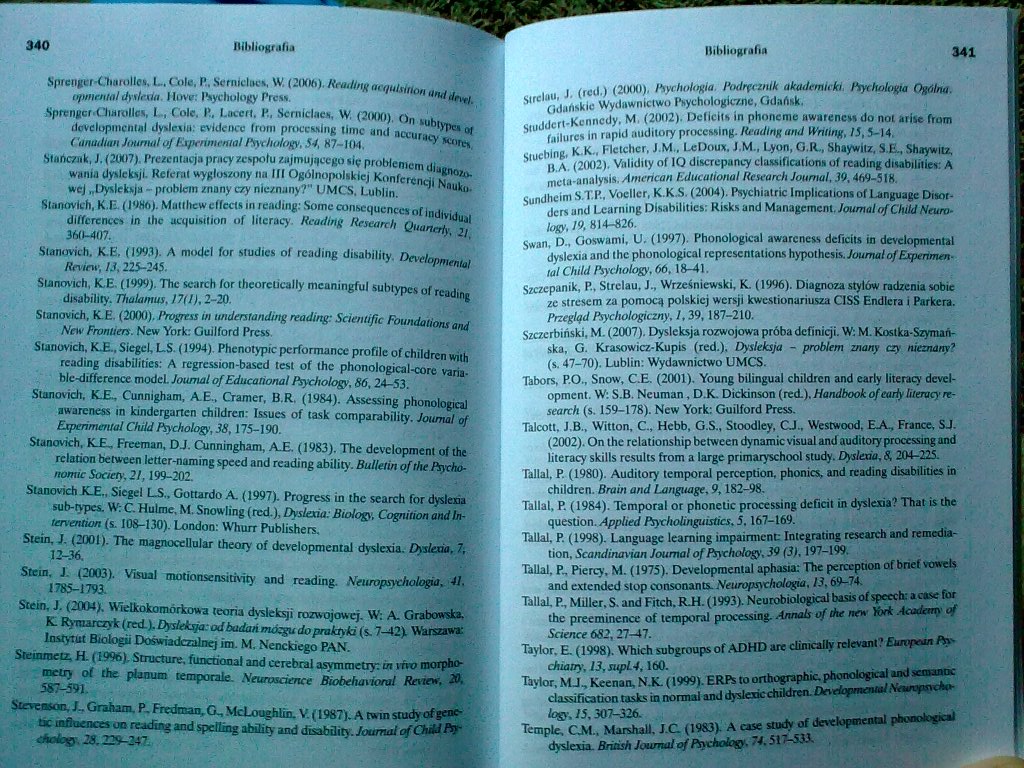Zdjęcie4042

340 Bibliografia
Sprenger-CharoHo*. L, Cole, R, .Semiclaw, W. (2006). Reading acr/utslrtm nnddmU upmaital tfyslecia. łlow: Ihychology Prosa.
Jłprcnficr.auimllw, 1., Cole. P. Lacen. P., Scmidoca. W. (2000), Ón Miblypaaf dovcłopmcm«l JysJc.ua: cvJJcncc from proce saing U mc and accuracy scom Canadian Journa l of Esperimemal ftyehdogy. 54, 87-104.
Stańczak, I. (2007). Prezentacja pracy zespołu zajmującego się problemem diagnozowania dyaleksji. Referat wygłoszony na III Ogólnopolskiej Konferencji Naukowej „Dyslcksj* - problem znany czy nieznany7“ UMCS. Lublin.
Stanovfch, K.E. (1986). Matthcweffects in reading: Somc cofuequcncc* of indlvidual diffcrcnccs in ihc acquisition of literacy. Reading Research Quarterty, 21, 360-407.
Stanovich. K.E. (1993). A moje! for studies of reading disability, Developmenlal Reiiew, 13,225-245.
Sianmich, ICH. (1999). The cearch for tbeoreucally mcaningful subiypes of rcoding disabillty. Thalamus, 17(1), 2-20.
Stanovidi, K.E, (2000),Progress in imderstanding reading: Scientific Foundationsand New Frontiers. New York; OuJIford Press
Sianovich, 1CŁ, SfegeJ, L.Ś. (1994). Phenotypfc performance profile of children wUb reading diubUities: A rcgreuion-based test of the phonologięal-cort wria-blc-dif(crenccnuxJcL/0tunalof£ducaiion4/Ayehology,86,2A~53. . StonovidT. ICH, Cunnigham, AE.. Cramcr, B R. (1984). Assessing phonotopcaJ awareness in Idnderganen chfldrcn: I&sues of task comparability. Journal of Ezpeńmemai Child Psychológy, 38,175-190.
Sunosich, K-E, Frectnan, DJ. Cunnmgham, A-E. (1983). The dcvelopment of the relation between letter-naming speed and reading ability. BuUetin of the Psycha-nomie Society, 21,199-202.
Stanovich K.E., Siegei LS., Gottardo A. (1997). Progress in the search for dysieró sub-r>pcs. W: C. Hulmc. NLSnowling(red.), Dyslesaa:Biolog, Cogniuonaadln-temaon (ł 108-130). London: Whurr Publisher*.
Stein, J. (2001). The raagnoceDalar theory of developmental dysiexia. Dyslexia, 7; J2-36.
Stein. J- (2003). Visual motionsensittaty and reading. Neuropsychoiońa. 41, 1785-1793.
Stein, J. (20Mf. Widkotomórkowa teoria dysfcksji rozwojowej. W: A. Grabowska, K-Rymarczyk (red.). Dysłekj/a: od badań mózgu do pruhyki($. 7-42) Warszawa: Instytut Biologii Doświadczalnej im. M. Nenckiego PAN.
Sadnmetz, H. (1996). Stractnre. fiincoooal and cerebtal asymroctiy: m riwo roorpho-metty of che pfemw wmporale Neurosdence Biobehavtond Revtew, 20, 587-591,
Steveasc0, J_, Graham. P. Fredcun. G-, McLooghlih. V. (1987). A win smdyof geoe-ńc ńtówacesoD reading and spelling abifity and disafeffity. Journal afOuU § Maff.28.22*-2*7.
Sirduu, J. (red.) (2000). Psychologia. Podręcznik akademicki, fityclwhgia Ogólna. GduAskie Wydawnictwo Psychologiczne, Gdańsk.
Studdcrt*Konncdy, M. (2002). Dedcłfs in phoncme uwarencM do not arite from failuroi in rapid auditoiy proccwlng. Reading and Wriilng, 15,5—14.
Stucblng. K.K., Flctchcr, J.M.. LeDoux. J.M., Lyon, G.IL, Shaywitz. S.Ł, Shaywitz. BA. (2002). \%lidity of IQ discrcpancy classiflcations of reading ditabiUtiec A mcta-analysis. American Educallonal Research Journal. 39,469-518.
Sundhcim S.T.P.. Vocllcr, K.KS. (2004). Psychiatrie Implicaiions of Language Dnor-dersand Lcaming DisabUitics: Risksand Managcmcni. Journal ofChdd Seum-logy, 19,814-826.
Swan. D.. Goswami, U. (1997). Phonoiogical awareness dcficits in developmcntal dyslcria and the phonoiogical rcprcscntaiions bypotbesis. JournalofEzpenmen-lal Child Psychology, 66,18—41.
Szczepanik, P.. Strclau. J„ Wrześniewski, K. (1996). Diagnoza stylów radzenia sobie ze stresem za pomocą polskiej wersji kwestionariusza C1SS Endtera i Parkęra. Przegląd Psychologiczny, 1,39,187-210.
Szczerbiński, M. (2007). Dysleksja rozwojowa próba definicji. W: M. Ko&lka-Szymait-ska, G. Krasowicz-Kupis (red.). Dysldaja - problem znany czy nieznany ? (l 47-70). Lublin: Wydawnictwo UMCS.
Tabors, P.O., Snów, CE (2001). Young btlingual children and earły literacy dcvel-opment. W: S.B. Neuman, D.K. Dickinson (red.). Handbook of cudy laerucy rr-search (s. 159-178). New York: Guilford Press.
Talcott, J.B.. Witton, C., Hebb, G.S., Stoodley, CJ.. Westwood, EA,, France, S4-(2002). On the reUtionship between dynamie risualandąuditoiy processing and literacy skilb tesults from a large primaryschool study. Dydeaa, 8.204-225.
TaflaL P. (1980). Auditoiy temporal pcrception, phonics, and reading disabilities io children. Bram and Language, 9,182-98.
lallal, P. (1984). Ifemporal or phonctic processing deficit in dyslezia? That is the question.vlpp/ied Psychobnguisócs. 5.167-169.
TalJal, P. (1998). Language learning impainnent Imegrating research and remedu-tion, Scandinmian Journal of Psychology, 39 (3), 197-199.
lallal, P_ Picrcy. M. (1975). Developrocntai aphasu: The perceptron afbrief voweis and extended stop consooants. Meurupsycholagu, 13,69-74.
ThllaL C Miller, S. and Fitch, RJi. (1993). Neurobiological basis of speech: acase for the precminencc of temporal processing- Annals of akr ne» \tuk Acadany of Science 682,27-47. Mjl ^
Taylor, E. (1998). Which subgroups of ADHD are dinically relevant? Europom Psychiatry, 13, supL4,160.
Taylor, MJ., Keenan, NJC. (1999). ERPs to oribograpłuc. piwnoiogicai andsemanoc teks in norami and dwlericduMren. DrwłnpaKninlNetnupn ck»-logyJS, 307-326.
Tempie, CM.. MarshalL J.C (1983). A case study of devdopmemal phonoiogical dyslesa. Bnńsh Jourmlof PSychołagy. 74.517-533.
Wyszukiwarka
Podobne podstrony:
Zdjęcie4040 336 Bibliografia Pietras, f. (2006). Dysortografia - problemy psychologiczne. Gdańsk: Wy
Zdjecie 0002 Uwaga Począwszy od semestru letniego 2006 na zajęcia laboratoryjne każda grupa powinna
Zdjęcie4032 320 Bibliografia Bogdanowicz. M. Adryjanck. A (2004). Uczeń z dysleksją w okolę. Poradni
Zdjęcie4034 324 Bibliografia Ellis, N„ Largc, B. (1987). The devdopmcn( of reoding: As you scck so s
Zdjęcie4035 326 Bibliografia Gaywa. J- Soi Ib. S.D„ Cberny, S-S.. Cardon, L-R- Fułker, D.W.. Kjmbert
Zdjęcie4036 328 Bibliografia Hart. R-. Kcm-all. R (2001). Impaircd Processing of rapid stimulus sei
Zdjęcie4037 330 Bibliografia Knvali K.A., Forness, S.R. (2000). Whai dcfinitions of Icaming dHabilii
Zdjęcie4038 332 Bibliografia Lovcgrt>vc, WJ.. Bowling, A . Badcock, D. Blnckwood, M. (1980). Spc
Zdjęcie4039 934 Bibliografia Nation, K., Snowling, MJ. (1998). Individual diffcrences in contcrtual
Zdjęcie4041 338 Bibliografia Sharc. DL <1995). Phoootogkml rccoding and aelf-ceaching: smr tjua n
Zdjęcie4044 344 Bibliografia Wagner, R.K.. Tbrgesen. JJC . Rashottc. CA.. Hccht !ŁAm Barter, TA, Bur
Zdjęcie4033 322 Bibliografia CostJes. Am Colthcart, M. (1996). Cognitive corrclalcs of dcvclopmcnul
Zdjęcie4043 342 Bibliografa Terapię, E. Poidract RA* Salidis, J* Dcutsch, G.K, lallal, P., Merzenich
18 Bibliografia prac Profesor Ewy Nowickiej 2006 Świat człowieka - świat kultury: systematyczny wykł
Zdjecie001 Twbm tEGZAMIN Z ANALIZY MATEMATYCZNEJ 1 rnnntt timwy 2006/07ZADANIA , ar* + * - 10
Zdjęcie1362 (2) Tworzenie bibliotek genów zmiennych fragmentów immunoglobulin ^-Zastosowanie łańcuch
więcej podobnych podstron